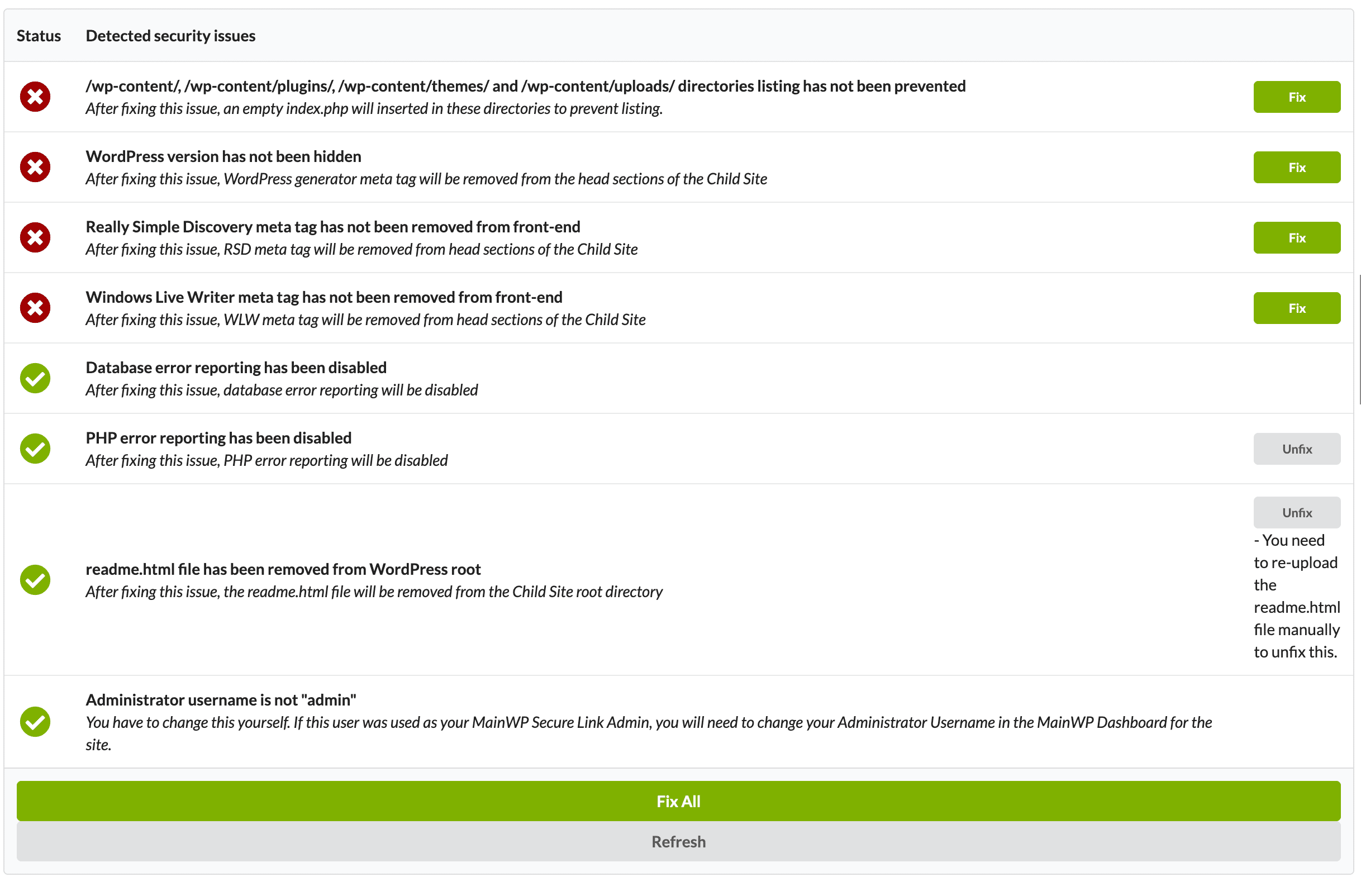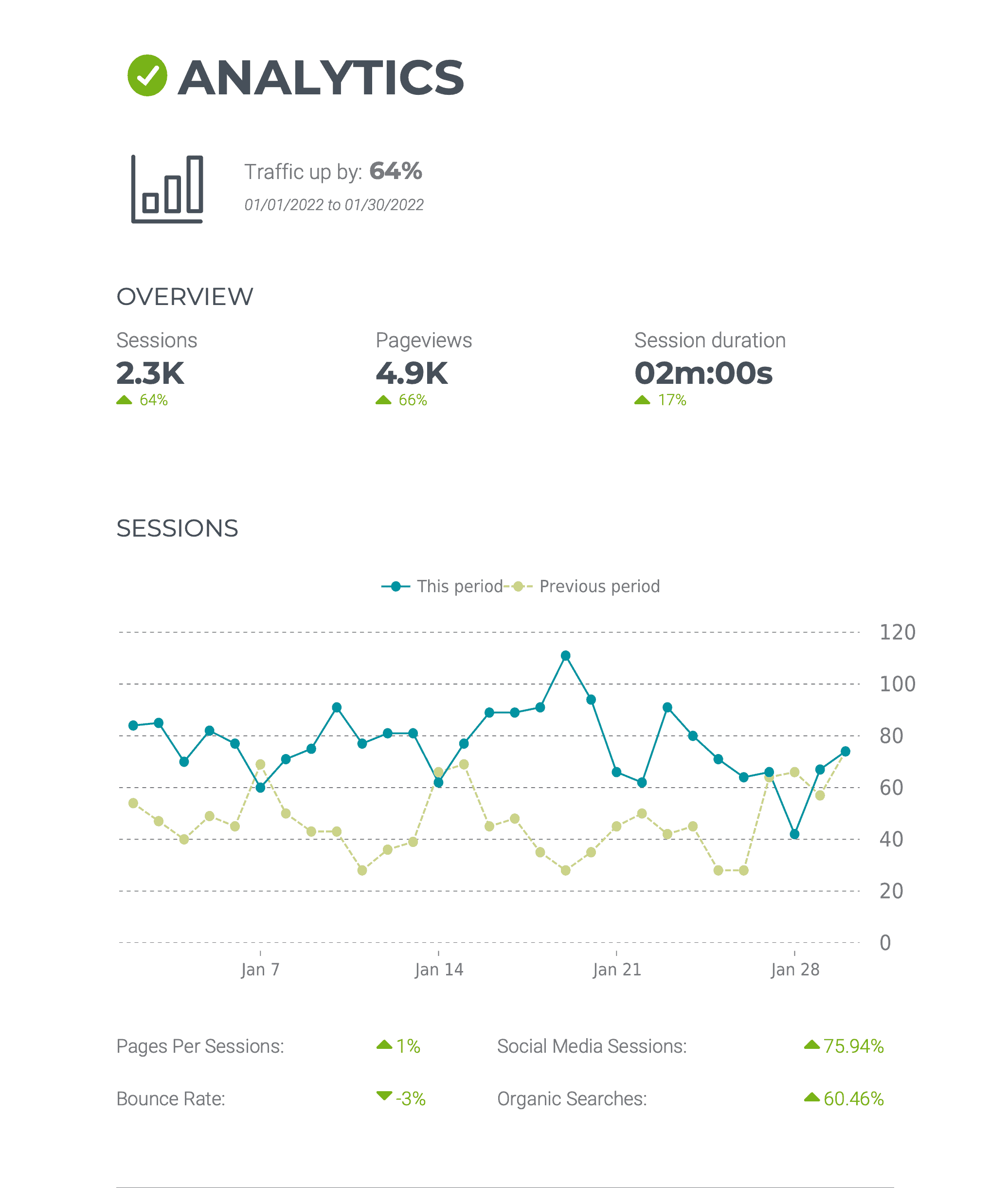ManageWP and MainWP are tools that allow you to manage or maintain multiple WordPress sites. If you have more than one WordPress site and you’re interested in managing them or are curious about the differences between ManageWP and MainWP, this post is for you.
Just a quick note that this post does not contain any affiliate links. All of the products listed here are ones I use in my business.
ManageWP
My journey with ManageWP began in 2017 when I started working with WordPress. Two of my colleagues recommended it as an easy solution to keep all of your sites in one place.
At first, I took advantage of their free features:
- Plugin, theme and WordPress updates
- Site optimization (database tables, spam comments and post revisions)
- Monthly backups
- On-demand security checks
- On-demand performance checks
- On-demand client reports
- Google Analytics integration
As my business grew, I started to use their daily backups, uptime monitoring and automated security checks. For clients on my higher level care plans, I configured and turned on automated reports.
ManageWP is a great platform — it’s very easy to add and manage multiple sites and I appreciated the clean and well-designed interface.
I did have a few issues now and again.
- Some sites would disconnect without any useful error message. I would sometimes reinstall the plugin, sometimes whitelist IP addresses, sometimes change the key, sometimes increase PHP values and when all else failed, I would contact support. Trying to debug and get a site reconnected wasn’t my favorite way to spend an afternoon. (Apparently this is a common complaint and they wrote a blog post about the most common website connection issues and how to resolve them.)
- One site would never stay connected. I talked to support, who sent me to the host, who sent me to Sucuri, who sent me back to ManageWP. I didn’t like having a site out there in the wild, not a part of my standard process and toolset.
At the end of 2021, I took their annual survey. There were a lot of questions about GoDaddy’s product, GoDaddy Pro. It made me a bit nervous that they would phase out ManageWP and push users towards GoDaddy Pro, so I posted about it on Twitter. (I was assured it was alive and well.)
But as I started talking with colleagues on Twitter and Slack, some mentioned MainWP. MainWP is very similar to ManageWP, but it’s self-hosted and you can install the extensions you want based on the features you want to use.
The pricing, however, is WAY different. From the end of 2018 through 2021 (a little over three years), I paid $1,604.07 for ManageWP. My December 2021 bill was $79.40 and that was with a 30% loyalty discount. I manage about 50 sites, but only about half of those have paid features turned on (backups, security monitoring, uptime monitoring, client reports). ManageWP has a bundle of 100 websites with all the features at $105/month. (Since I’ve removed my sites from ManageWP, I see that my loyalty discount is now 10% and the bundle price is $135/month.)
The free version of MainWP does quite a bit, but the pro version is $399. That’s it. Since I’m paying about $80/month now, I’d only need to use MainWP for about 5 months before I broke even.
Trying out MainWP
Before I bit the bullet, I took MainWP for a test ride. I created a new, blank WordPress install for the MainWP parent. Then, I installed the MainWP child plugin on this site and connected the two. The first child site didn’t connect with the wizard, so I repaired the database, added the site again and it worked. MainWP listed some security issues to fix, so I did.

I added the free Updraft extension since I use Updraft to back up many of my sites and the free Advanced Uptime Monitor extension to connect with my UptimeRobot account.
Upgrading to MainWP Pro
As I got more comfortable with MainWP and weighed the pros and cons, I decided to bite the bullet and upgrade to the lifetime version of MainWP Pro. My goal was to replicate the functionality I used with ManageWP.
Backups
Previously, I used paid ManageWP backups on half of my sites and Updraft backups on the other half. Since I would now be using Updraft for all of my sites, I had to adjust my Updraft plan from the Agency level the Enterprise level. I now pay $117/year for Updraft and can back up an unlimited number of sites.
I love that all of my backups are in the same place now (on Dropbox). I can manage backups individually (per site) and globally (for all sites), plus hide the backup plugin on my child sites if I want to.
One drawback is that older Kinsta plans don’t allow Updraft, so I have one lone site that’s not connected right now. (Newer Kinsta plans do allow Updraft.) The other challenge with this site is that the client exclusively uses a staging site and always pushes to live, so I’m unsure how to configure. Regardless, I like to have my own set of backups (beyond what the host offers, if your host offers backups at all), so for now I still have the staging site connected to ManageWP and the paid backups turned on.
Uptime Monitoring
UptimeRobot has a free plan that includes 50 sites, but since I would now need more monitors in the consolidation, I snagged a lifetime AppSumo deal for Better Uptime for 200 sites.
Security
ManageWP has the option for daily, automated security scans, but MainWP does not. You can, however, do on-demand scans with their free Sucuri Site Check extension, so I set that up.
All of my sites use Wordfence and are connected to Wordfence Central. With the Wordfence extension, I can manage Wordfence individually (per site) and globally (for all sites). I can also configure all of my sites to use the same settings (which you can do with Wordfence Central templates, but I found those to be buggy).
Although still in beta, I also tried out Virusdie. When you sign up through MainWP, all of your sites on your MainWP dashboard are scanned once per week. I did have some issues connecting a few sites, but Virusdie support was pretty good and now everything is connected and scanning. Virusdie also found a few issues on my sites — mostly in old folders outside of the main WordPress install. They sent me an email with specific information on the vulnerabilities found, which was awesome and informative. It also helped me to investigate some of my older (and inherited) websites a bit more closely. March 2022 update – I am no longer using Virusdie due to website connection issues.
Google Analytics
Setting up the Google Analytics extension took a long time because you have to dig into the Google Cloud Platform settings, create a project, enable the GA API, create keys — it’s a whole thing. There’s no support for GA4 just yet, and the solution is to create a Universal Analytics account when you’re creating a GA4 account, which isn’t always practical.
Maintenance
I frequently used the optimization feature in ManageWP — to clean spam comments, remove post revisions and optimize the database. There’s an equivalent Maintenance extension for MainWP that performs these tasks and a few more, plus you can schedule maintenance. One drawback is that I can’t see the optimizations by site beforehand like I could with ManageWP.
Client Reports
One of the features of my higher level care plans is a monthly client report. ManageWP client reports are very professional and thorough. You can customize MainWP client reports quite a bit, but there are definitely some differences. Some say that clients don’t look at these reports anyway, so maybe I’m worrying for nothing. You also have to install the Client Report plugin on child sites, but you can hide this.
If you have GA connected, you can show some data in your client report but it’s far inferior to the ManageWP client reports. When I notified my clients of the change in reports, I mentioned that I would create an automated report directly from GA if they liked (to hopefully fill that gap).

Additional Pro Tweaks
Extensions
I went through their list of extensions and chose some that I thought would work for me.
- MainWP looked a bit dated (especially when compared to ManageWP), so I took some time to update the colors and fonts using the Custom Dashboard extension
- The Lighthouse extension is pretty cool and allows you to check your Lighthouse scores across ALL of your sites at once
- WP Rocket is a caching plugin that I use regularly, so I installed the Rocket extension. Like with Wordfence and Updraft, you can manage WP Rocket individually on a site or globally on all sites and you can hide the plugin on child sites
- Using the Favorites extension, I added a few plugins to my favorites list
I also installed these extensions but haven’t investigated them yet:
- White Label (formerly Branding)
- Code Snippets
- Comments
- Custom Post Types
- URL Extractor
ManageWP has some similar functionality like White Label and Code Snippets, although I never used them there.
March 2022 update – I removed some of the extensions that I wasn’t using and will install them later if I decide I need them.
Parent Site
I made a few additional tweaks to the parent site as well:
- Added WP Mail SMTP configured with MailGun to send emails (client reports and other notification emails like the daily digest)
- Installed WP Mail Catcher to log emails sent (just in case) (and I could switch to Fluent SMTP or similar to consolidate to one plugin instead of having two)
- Enabled 2FA using Wordfence
Final Thoughts
MainWP has a knowledge base, a forum and a Facebook group for questions and other resources. I’ve spent time on each to get to know the product and the features. Scott at Barrel Roll has answered so many of my questions about MainWP and I’m grateful for his thoughts and advice! Kari at Iceberg also took the time to show me around MainWP which was awesome.
Changing from ManageWP to MainWP took a lot of time. Now that it’s set up, I don’t expect it to take up as much of my time in the future, but it was a decent initial investment. One great thing that came out of this change was a VERY streamlined process. All of my sites are now configured the same way, which wasn’t really the case before.
If you’re considering a move to MainWP (or ManageWP) and want to chat, hit me up on Twitter and let’s discuss!
